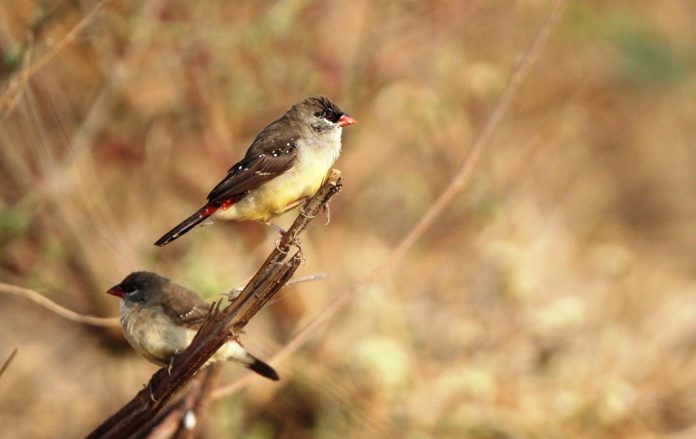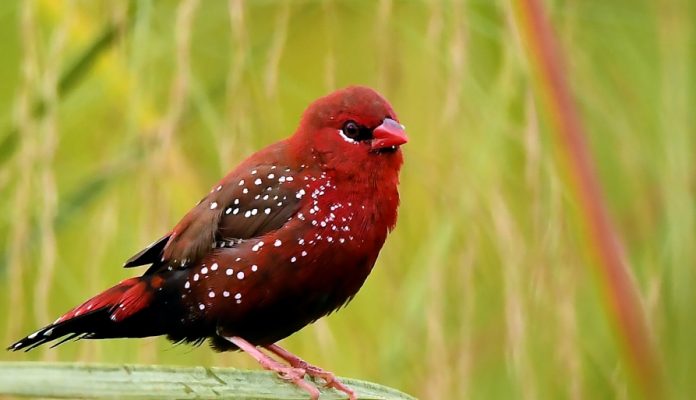IDENTIFICATION
Red Avadavat is 9 cm in length. This bird species is a locally established introduction from tropical Asia in the Iberian Peninsula, Northern Italy, and Egypt. This is a beautiful, tiny, and sociable finch-like bird of reedbeds and grassland. The adult male is bright crimson, with a blackish ventral region, wings, and tail; closer views reveal the body and wings to be freckled with tiny white spots, most obvious on blacker wings and on flanks, and a narrow white fringe to the tail. It is also known as the red munia or strawberry finch.

Adult male winter and adult female are significantly duller, being dull brown above and grayish-buff below, washed with yellow on the belly but with an obvious bright crimson rump and bright red bill; closer views reveal lines of small white spots across dark wings.
Compared with the adult female Red-billed Firefinch, they are a bit shorter-tailed, have less pale eye rings, and have tiny white spots on wings (female Red-billed Firefinch has small white spots constrained to the breast). The red rump simply prevents confusion with the common waxbill.
The juvenile bird is a little duller, with a dull brown rump and dusky bill. It appears browner, bufferier, and shorter-tailed than Common Waxbill and is nearly always in the company of more distinctive adults. Usually in tight, small flocks, they are often seen whirring quickly along the tops of waterside vegetation, dropping to feed just inside the tops of swaying reeds, but also sometimes on the ground at the base of reeds.
Generally, it is a quiet and shy bird and is often seen only in flight when the red rump is eye-catching. Comparatively large round nests are usually well hidden in the bases of reeds.

DISTRIBUTION
Most likely confusion is with the red-billed firefinch, but the range does not overlap, the habitat is quite different, and the latter is longer-tailed, has brown wings, a pale eyering, and lacks white spots (apart from some tiny spots on the breast). There are four subspecies; however, amandava species are found in India, Pakistan, Bangladesh, Nepal, China, Vietnam, Indonesia, and Thailand.
SEX/AGE
Adult male winter is grayer on head and throat than an adult female. In the beginning, the juvenile has a blackish bill (becoming reddish-brown) and is buffer below, less yellowish than the adult female, with brown rather than red rump and buff, and no white spots on wings.

CALL / SONGS
Red Avadavat calls include a musical series of high-pitched chirps and a short husky squeak. However, the Red Avadavat song is a high-pitched continuous twittering.
HABITAT – Red Avadavat is not uncommon but highly localized. Therefore this is now an established introduction in N Egypt (Suez, El Faiyum, Nile delta), Iberian Peninsula, and probably N Italy. It is found at reed beds and papyrus beds, flat plains, rushes, sedges, and neighboring grassland and cultivation fields (mostly wet rice paddies). In the moon soon seasons, it breeds in the subcontinent.

BEHAVIORS – They are mostly seen in the small flocks, can fly with quick wing beats, and feeds consist of insects, seeds, and termites. They prefer to build a globular nest with grass blades. The nest contains 5 to 6 white colors eggs. The beaks turn red in May, but it gets to their peak in November and December.
Related Readings: Common Rosefinch








